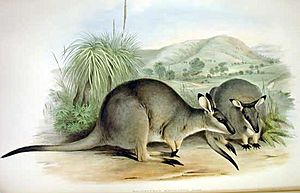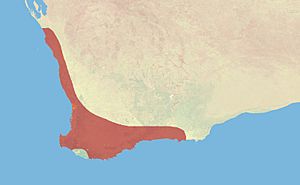Western brush wallaby facts for kids
Quick facts for kids Western brush wallaby |
|
|---|---|
 |
|
| Conservation status | |
| Scientific classification | |
 |
|
| Western brush wallaby range |
The western brush wallaby (Macropus irma), also known as the black-gloved wallaby, is a type of wallaby that lives in the southwestern coastal part of Western Australia. This wallaby's biggest threat is being hunted by the red fox (Vulpes vulpes), which was brought to Australia.
The IUCN says the western brush wallaby is of Least Concern. This means its population is quite stable or even growing. This is thanks to programs that help control the number of red foxes.
The western brush wallaby has grey fur with clear white markings on its face, arms, and legs. It also has black "gloves" on its hands, which is why it's sometimes called the black-gloved wallaby. It's a diurnal (active during the day) macropod, which is a bit unusual for these animals. It mostly eats grass.
Contents
About the Western Brush Wallaby
The western brush wallaby was first described by a scientist named Claude Jourdan in 1837. People also call it the black-gloved wallaby or the kwoora.
This wallaby belongs to a group of animals called Diprotodontia. These are marsupials that have special teeth for eating plants. They have one main pair of front teeth in their lower jaw. They also have three pairs of upper front teeth. These teeth are perfect for a plant-based diet.
The western brush wallaby is part of the largest family of marsupials, called Macropodidae. This family includes kangaroos and other wallabies. Scientists believe these animals once lived in trees but later moved to live on the ground.
Some local names for this wallaby come from the Nyungar language. These names are kwara (pronounced kwa'ra) and koora (koo'ra). These are the names suggested for this species.
What Does the Western Brush Wallaby Look Like?
The western brush wallaby is a type of Macropus. Its head and body can be up to 900 millimeters (about 3 feet) long. Its tail can be from 600 to 950 millimeters (about 2 to 3 feet) long. When it stands up, it's about 800 millimeters (around 2.6 feet) tall.
This wallaby has a gunmetal grey color, similar to the larger kangaroos in its area. Its tail is very long compared to its body size. An adult western brush wallaby usually weighs between 7.0 and 9.0 kilograms (about 15 to 20 pounds).
It has a pale to mid-grey coat. A clear white stripe runs from its ear to its mouth. Other special features include black and white ears, black hands and feet, and a crest of black hairs on its tail. Sometimes, you can see faint dark stripes on its back and rump. Male and female wallabies are quite similar in size.
Western Brush Wallaby Behaviour
Most western brush wallabies are active and feed during the daytime. This is different from most other macropods, which are usually active at night. When they run away from someone, they hold their body low, with their tail stretched out and head down.
Not a lot is known about the specific behavior of the western brush wallaby. However, much of what they do is similar to other animals in the Macropodidae family.
Diet and Feeding Habits
The western brush wallaby is a herbivore, meaning it only eats plants. Scientists are still studying exactly what it prefers to eat. Some think it mainly eats leaves (a browser), while others believe it mostly eats grass (a grazer).
It is active during dawn and dusk, which is called crepuscular. This is somewhat unusual for macropods, as many are nocturnal. During the hottest part of the day and at night, it rests alone or in pairs. They find shelter in bushes and small thickets.
These wallabies eat many types of plants. Some common foods include Carpobrotus edulis, Cynodon dactylon, and Nuytsia floribunda. One study suggests their diet is mostly made up of leaves from low shrubs (79-88%). They also eat some grasses, sedges, and other small plants. Their stomach has four parts, which helps them digest tough plant material. They seem to be able to live without needing to drink water.
Reproduction and Life Cycle
Even though scientists have studied them for many years, the exact details of the western brush wallaby's reproduction are not fully known. The young are usually born in April and May.
Like all marsupials, females have a well-developed pouch that opens forward. Inside the pouch, there are four teats for feeding the baby. The female usually gives birth to one young at a time, though two are very rare. The baby grows inside the mother for about three to five weeks before birth.
After birth, the young wallaby stays in the pouch and drinks milk for seven months, until October or November. Once it leaves the pouch, it goes through a weaning period. During this time, it might still put its head back into the pouch to drink milk.
Movement and Speed
Like all animals in the Macropodidae family, western brush wallabies have strong back legs and long back feet. They run by weaving or moving sideways, using their powerful hind legs. They keep their head low and tail straight, which helps them move very fast.
Western brush wallabies have a special feature on their hind feet called syndactyl toes. This means their second and third toes are joined together, except for the very tips where two slender claws stick out.
Macropods are unique because they are "pentapedal." This means that when they move slowly, they use their front limbs and their tail to support their body weight. This allows their strong back legs to swing forward. This slow movement can look a bit awkward. When they move quickly, their fourth toe (which is the longest and strongest) helps them hop. The tail helps them keep their balance. Their back legs cannot move backward or separately from each other (unless they are swimming or lying on their side). This makes their hopping motion very energy efficient. The front limbs of macropods are small and not very strong.
Where Western Brush Wallabies Live
The western brush wallaby lives in the southwest coastal area of Western Australia. You can find them from Kalbarri all the way down to Cape Arid. They are especially common near the Swan River.
They live in areas with mallee (a type of eucalyptus tree) and heathland (open land with small shrubs). They are not common in wet sclerophyll forests because the plants there are too thick. They prefer tall, open forests that offer good grazing areas. They especially like open, sometimes damp, flat areas with low grasses and open scrubby bushes. This open habitat helps the animal move quickly, staying low to the ground.
Population and Conservation Status
When Europeans first settled in Western Australia, the western brush wallaby was very common. Soon after, people started trading wallaby skins.
Animals brought from other countries have had a huge impact on Australia. In the 1970s, the number of western brush wallabies started to drop. This happened as the population of the red fox grew a lot. Red foxes especially hunted young wallabies as soon as they left their mother's pouch.
A survey in 1970 in the Jarrah Forests found about 10 wallabies per 100 square kilometers. By 1990, another survey showed the population had dropped to only 1 wallaby per 100 square kilometers. During this time, the population of the western grey kangaroo stayed the same. Kangaroos are much larger than wallabies, which might have protected them from the foxes.
In the 1990s, a scientist named Kinnear found a good way to control red foxes. He used meat and egg baits with a special toxin called "1080," which is safe for the environment. His method worked well and helped the western brush wallaby population recover. It also helped other animal populations.
Today, there are about 100,000 western brush wallabies. Because of this recovery, the western brush wallaby was moved from the "Near Threatened" list to the "Least Concern" list by the IUCN.
Even though controlling red foxes has helped the population a lot, their habitat is still being cleared for farming. This means their population is still spread out in smaller groups, and their living area has shrunk.
See also
 In Spanish: Macropus irma para niños
In Spanish: Macropus irma para niños


